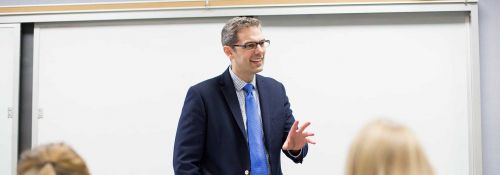
Understanding the Trivium and Quadrivium
Dr. Jeffrey Lehman Explains the “Arts of the Word” and the “Arts of Number”
Written by Finn Cleary
Many academics disagree about the importance and place of both the trivium and quadrivium. Dr. Jeffrey Lehman, a professor in Hillsdale’s education department, sees a deep connection between the two and is teaching classes on both this semester.
“[The trivium and quadrivium] lead us to speak with clarity and see the relations between things,” Dr. Lehman says. “Keeping that in mind, it helps to overcome the old opposition between humanities and sciences. You can understand how a university is a university when you understand those basic concepts.”
The trivium consists of grammar, logic, and rhetoric, while the quadrivium consists of arithmetic, astronomy, music, and geometry. Together, Dr. Lehman says they lead students to see a “unified idea of reality.”
“The trivium was always pursued first,” Dr. Lehman says. “It’s commonly called the ‘Arts of the Word’ and focuses on different ways you can attend to words. Grammar is used in logic, which is used in rhetoric, for example. All of them move toward a proper presentation of the truth, which speaks to the mind and to the passions.”
Next, students of the liberal arts traditionally move to the quadrivium, or the ‘Arts of Number or Quantity.’
“Humans communicate with each other using words. Humans communicate with the natural order in numbers and in quantities. By discerning those natural relationships, we come to better understand the cosmos. It speaks to us, and we can talk to the greater universe. “
Dr. Lehman focuses not just on the study of the liberal arts but the practice of them. “It’s one thing,” he says, “to think about the arts historically, to describe them, but to practice them is what has happened for centuries, and what I try to do here is make my students practice them.”
Practicing the liberal arts involves uncovering the beginning principles of each art, which span out into lines of reasoning, and then connecting them.
“For instance, in logic, you start with looking at the terms, categorizing them, then working them into propositions and figuring out how they relate to each other and form syllogisms and so on.”
Balancing the relationship between the humanities and sciences provides trenchant insight into the practicality of a liberal arts education. However, Dr. Lehman’s classes aren’t just for practical benefits.
“Plato saw the difference between the lower utility of using geometry to construct a temple and a higher utility of forming the soul,” he says. “These arts each contribute to the formation and ordering of the soul, and that is the amazing capacity of the liberal arts.”
 Finn Cleary, ’18, is from the cultural hub of America, Columbus, Ohio. He plans on majoring in History and working in the public policy field.
Finn Cleary, ’18, is from the cultural hub of America, Columbus, Ohio. He plans on majoring in History and working in the public policy field.